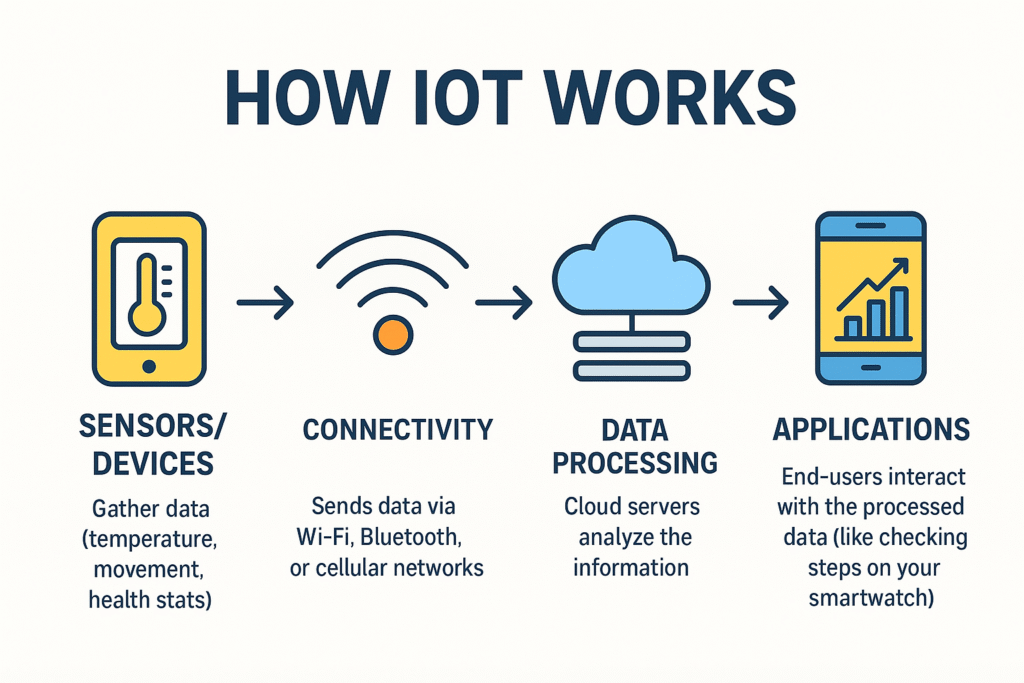Introduction to the Internet of Things (IoT)
What is IoT? The Internet of Things (IoT) is a network of everyday objects—like smartwatches, refrigerators, cars, and even buildings—that can connect to the internet and share data. Simply put, IoT turns ordinary devices into “smart” ones by allowing them to collect, exchange, and act on information.
If you’ve ever asked Alexa to play music, checked your home camera remotely, or worn a fitness tracker that monitors your heart rate, you’ve already used IoT without even realizing it.
The Evolution of IoT: From Concept to Reality
Early beginnings of connected devices
The idea of machines communicating isn’t new. In fact, the first “connected device” dates back to the early 1980s when a Coca-Cola vending machine at Carnegie Mellon University was modified to report its inventory and temperature. This was one of the earliest examples of what we now call IoT.
Milestones in IoT development
- 1999: The term “Internet of Things” was coined by Kevin Ashton.
- 2008: More “things” were connected to the internet than people.
- 2010s: IoT adoption skyrocketed with the rise of smart homes, cloud computing, and mobile apps.
What is IoT and How Does It Work?
Core components of IoT
IoT works through four main elements:
- Sensors/Devices – Gather data (temperature, movement, health stats).
- Connectivity – Sends data via Wi-Fi, Bluetooth, or cellular networks.
- Data Processing – Cloud servers analyze the information.
- Applications – End-users interact with the processed data (like checking steps on your smartwatch).
Real-world example
Imagine a smart thermostat. It uses sensors to detect room temperature, connects to Wi-Fi, processes the data, and adjusts heating or cooling. You can even control it remotely using your smartphone.
Key Features and Characteristics of IoT
- Always connected: Devices stay online to transmit data.
- Automation: Smart actions based on data insights.
- Scalability: Can expand to millions of connected devices.
- Integration: Works with AI, cloud, and 5G networks.
What is IoT in Everyday Life? Applications You Use Daily
Smart homes and connected appliances
From smart TVs and voice assistants to refrigerators that notify you when you’re out of milk, IoT is transforming how we live.
IoT in healthcare and wearable tech
Wearables like Fitbit and Apple Watch track steps, heart rate, and even detect irregularities in your health. Hospitals also use IoT for remote patient monitoring.
IoT in transportation and smart cities
- Smart traffic lights reduce congestion.
- Connected cars send data for predictive maintenance.
- Cities use IoT for energy-efficient street lighting.
Industrial IoT (IIoT) and business applications
Factories leverage IoT for predictive maintenance, supply chain monitoring, and improving workplace safety.
Benefits of IoT: Why It Matters
Efficiency and automation
IoT reduces manual effort by automating routine tasks like scheduling, controlling devices, or monitoring systems.
Cost savings and resource optimization
Smart energy meters cut down electricity bills, while companies save costs by preventing equipment breakdowns.
Better decision-making with data
Real-time analytics allow businesses and individuals to make smarter, faster choices.
Challenges of IoT and Security Risks
Security and privacy risks
With more devices connected, the risk of hacking increases. Data breaches remain a top concern.
Connectivity and infrastructure challenges
Reliable internet access is essential, which can be a barrier in rural areas.
Interoperability issues
Different brands and devices often don’t work seamlessly together, creating integration problems.
Future of IoT: What’s Next?
Emerging trends in IoT
- Edge computing to reduce delays in data processing.
- Smart agriculture for monitoring crops and livestock.
- IoT in education with connected classrooms.
Role of AI and 5G in IoT
AI makes IoT smarter by predicting behavior, while 5G networks provide lightning-fast connections, enabling real-time communication between millions of devices.
Read More
- An Introduction to Arduino IDE and ESP32: A Powerful Combination for IoT Projects
- For hands-on IoT projects, visit CircuitofThings.com
FAQs about IoT
Q1. What does IoT mean in simple words?
IoT is when everyday objects connect to the internet to share and use data.
Q2. Is Alexa an example of IoT?
Yes, voice assistants like Alexa are a part of IoT.
Q3. How many IoT devices exist today?
As of 2025, there are over 15 billion IoT devices worldwide.
Q4. What is the biggest challenge in IoT?
The biggest challenge is data security and privacy.
Q5. Can IoT work without the internet?
Some devices can work locally, but most IoT systems need the internet for full functionality.
Q6. What industries benefit the most from IoT?
Healthcare, manufacturing, transportation, and retail are leading adopters.
Conclusion: Why IoT Matters for the Future
The Internet of Things isn’t just about gadgets—it’s about making life easier, smarter, and more efficient. From saving energy at home to revolutionizing industries, IoT is shaping the future of technology.
If you want to dive deeper into the world of connected devices, check out resources like IoT Agenda by TechTarget.
